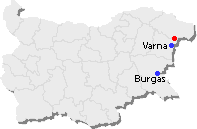
The Aladzha is a bulgarian medieval cave monastery complex situated about 16 km from the city of Varna and 3 km from the Black Sea beach resort Golden Sands. The word “aladzha” is of Turkish origin and means colorful and bright. Probably the reason to give that name to the monastery was the lively frescoes from the Early Medieval.
As per historians primitive monastic cells were hewn into the rock and inhabited by the 4-th C. The first archeological materials refer to the early Byzantine period – coins from the Constantine (4-th C.) and the Justinian times (5-th C.) and also few ceramic parts found near the rocks. Those materials are still not enough to prove that the monastery have existed at that time. Most probably the caves were used by the people as a shelter during the barbarian invasions. Housing in such places in the rocks was typical for the coastal part of Northeastern Bulgaria. It is proved that the monastery has achieved its complete appearance in 12-th C.
The monastic cells, the common premises and the chapel built in the limestone rocks and located on two levels above ground are connected via external stairs. On the ground floor were to be found the monastic rooms, the kitchen, the living room and a little church. On the upper floor was only the chapel.
Unfortunately only a little part of the unique frescoes is preserved, most of them in the chapel. In 1912 the Aladzha Monastery is announced as a historical monument and in 1957 as a national heritage.














